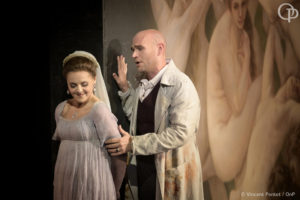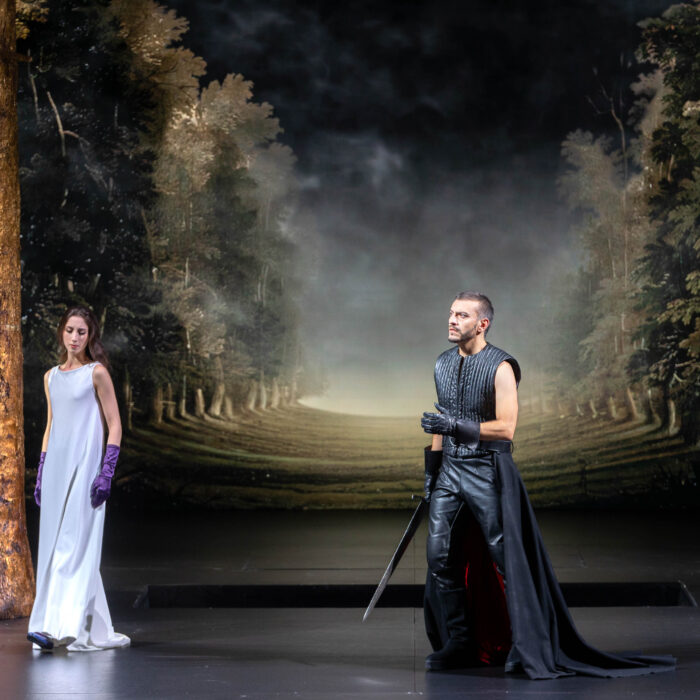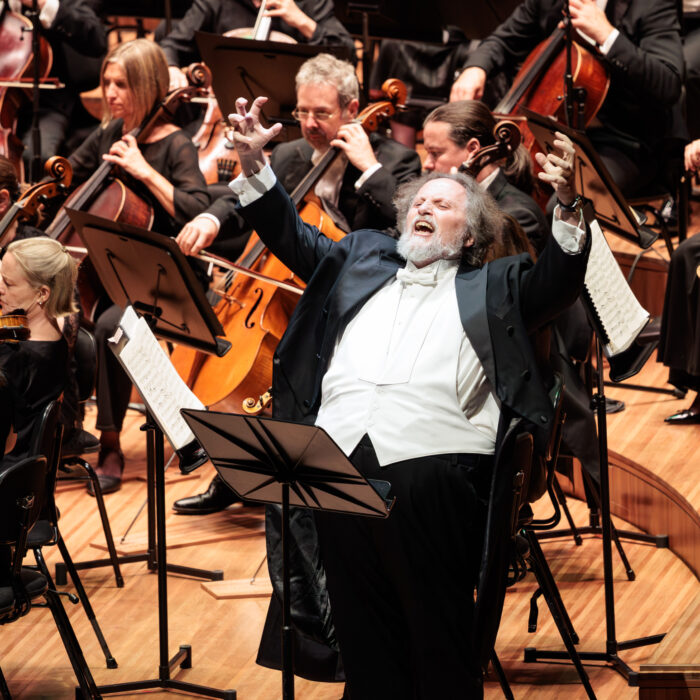
Opéra National de Paris 2020-21 Review: Tosca
Maria Agresta & Michael Fabiano Make Incredible Debuts in Pierre Audi’s Inconsistent Production
By Mauricio Villa(Credit: Vincent Pontet/Opera de Paris)
This review is from the opening night on the 4th of June 2021
For months the Opéra de Paris was doing it all it could to reopen. But the pandemic would not allow it. The result was that many productions were forced on digital platforms, including its recent “Faust” showcase.
But alas, after 15 months of closure, the Opéra Bastille finally reopened its doors for a production of “Tosca” featuring the double debut of Maria Agresta and Michael Fabiano in the leading roles. Surely for live audiences, this was set to be a treat for all of these reasons. And it was all worth the wait.
The Evolution of Agresta
Agresta took on the title role for the very first time, showing off her brilliant secure top notes. But most impressive to me was to see how her voice has evolved to suit all the demands of this dramatic part.
The first act is a perfect warm-up for sopranos. Not only is it the shortest act for the soprano, but the tessitura doesn’t rise above A naturals and B flats. Agresta focused on portraying a jealous lover, with long legato lines, including an exquisite, piannissimo high B flat on “le voci delle cose.” She also showed off the power and darkness of her voice during her jealous outbursts.
Act two is the real tour de force for the soprano. Not only does the tessitura increase with several high Cs, B naturals, and B flats, but all these lines that rise up to the high notes require fortissimo over a dense orchestration. Agresta displayed secure onset on the thunderous high notes (three high Cs), always perfectly on pitch (something that not all sopranos manage to do as they fight to be heard and sound dramatic), all while portraying all of the anguish and pain that the heroine is suffering while is being sexually harassed by Scarpia. She managed to build a climax full of tension and desperation gradually, without resorting to the mannerism of the old Verismo school, remaining true to her performance and control of voice production. Her “Quanto? Il Prezzo” or “Questo il bacio di Tosca” was terrific; she mixed the chest voice and spoken words, producing a hair-raising effect.
The challenge for any “Tosca” interpreter is that no matter how incredible you’ve been for nearly two acts, the audience is waiting for you to deliver on one moment: “Vissi d’arte.” It literally breaks the momentum of the show and, with a poor performance, can ruin a soprano’s momentum as well. But that was not the case for Agresta produced a fresh-sounding voice, full of control in the middle register, something surprising considering how much intensity she had put into her singing in the passages leading up to this one. Agresta’s interpretation of the aria was full of emotion, long legato lines, a splendid climactic high B flat, and a subsequent diminuendo to pianissimi on an A flat and G, keeping the sound soaring magically.
In the third Act, a traumatized Tosca seeks out Mario to tell him about Scarpia’s murder. Agresta managed a freshness of voice for the devilish line “Io quella lama gli piantai nel cor” where she ascended to a brilliant high C. Throughout the rest of the act, Agresta was vocally impeccable, but somehow, I found some emotional detachment during the moments when Tosca recalls Scarpia’s murder (maybe this was her way of expressing an attempt to repress the incident?). Ultimately, Agresta portrayed an amazing depth of character, making her performance always believable and moving. This was undeniably an excellent debut for the Italian soprano who could very well become one of the greatest Toscas today as she matures and further develops her interpretation.

Credit: Vincent Pontet/Opera de Paris
A Rapturous Turn
American tenor Michael Fabiano’s Cavaradossi follows other Puccini roles in his repertoire, namely Rodolfo in “La Bohème,” which has become one of his signatures. But Cavaradossi’s vocalitá requires a heavier spinto voice, which I believe Fabiano has due to his dark metallic timbre, incredible volume, and natural squillo. But he has taken his time to get to this role, taking on more lyrical roles throughout his career, allowing him to stretch his tessitura and develop his legato singing. And this experience was noticeable in his interpretation of Cavaradossi, particularly in the first act with his fraseo lines and several effortless ascensions to B flat.
He sang his entrance aria “Recondita armonia” joyfully, navigating the high tessitura of the aria fluidly, and delivering the first bright B flat of the night. He delivered the high B flat on “Ah! M’avvinci ne’tuoi lacci mia sirena” with a perfect clean attack on the note, avoiding the use of apoggiature or portamenti.
The duet with Tosca is extremely lyrical, full of long legato lines which also denies the use of portamenti, a very popular resource in the verismo repertoire. Fabiano sang with sweetness and ardent love during “Quale occhio al mondo” navigating easily through a B flat and softening the sound in contrast to the more expansive ardent lines of the duet. The tenor also pulled off a vibrant high B natural on “La vita mi costasse, vi salveró.”
The second act is shorter for the tenor with just a few short edgy lines while he’s being interrogated by Scarpia. There was a moment of extreme dramatic tension when Scarpia gets closer to Mario, and Fabiano, instead of stepping backward, stood firmly and lifted his chin in a confrontational stance. Fabiano’s voice is so big that when he sang his laments offstage, he sounded as if he were singing right on the stage. The big moment of the second act is “Vittoria, vittoria” where he is forced to deliver a high B flat. Fabiano’s voice was thrilling, menacing and strong, and he managed the top note without pushing the sound; he also avoided the vulgar (in my opinion) effect of holding the note for an exaggerated among of time, instead opting to sing it as written in the score.
He was amazingly menacing and desperate in “Scarpia carnefice,” his voice crescendoing with violence and the last line delivered with a hoarse cry.
Like with Tosca, the tenor’s big moment comes down to Act three’s “E lucevan le stelle.” As the curtain rose on this act, one could see Fabiano’s devastated mental state full of extreme anguish and abandonment, his eyes wet with tears and lost in the horizon as he crept around. Watching this, I knew that his aria was going to be deeply moving. He delivered with creamy legato lines and an exquisite mezza voce on “Oh, dolci baci,o languide carezze… la belle forme disciogliea dai veli,” which included pianissimi singing in the pasaggio around F sharp and high A natural. He also avoided mannerisms associated with verismo singing, giving the aria an added vocal elegance.
He maintained this sweetness of sound throughout his last duet with Tosca, “Oh dolci mani,” managing the dynamics as written in the score (piano singing in the lower register). At the end of the duet, he delivered a powerful B natural that carried perfectly into the auditorium.
Impressive All Around
Scarpia’s writing is so ambiguous that the role has been sung by bass-baritones and even basses with solvent high notes. It does not imply a big vocal challenge for a baritone, as the tessitura is quite comfortable (it only has a single high F sharp, and it stays mostly around C and E, with some ascensions to F). The problem when a baritone sings this role is the volume. Scarpia demands a large, dark voice to sound menacing and frightful. Tézier, who premiered this production in 2014, has a large voice and was striking on the E in his entrance line “Un tal baccano in chiesa.”
He portrayed a cold Scarpia in the first act, slightly cynical as he preyed on Tosca’s jealousy, but always controlled. He unleashed his vicious personality on his explosive line ”Tosca mi fai dimenticare Iddio.”
The second act is the real challenge for Scarpia, and Tézier was truly despicable here as his performance was fueled by believable emotions that provided psychological layers to the character rather than just playing up a clichéd monster as many other interpreters do. His Scarpia was also impressive and vocally impeccable.
Of the rest of the characters in the opera, I want to single out Carlo Bosi’s Spoleta; Bosi possesses a rich tenor with a fair vibrato and a frightening personification of the role.
Pierre Audi’s production is evocative and meaningful, exploring the power and control of the church and political order with a giant crucifix present in every Act. The first two acts are abstractions of the church of Sant’Andrea delle Valle and of Scarpia’s study, with a dramatic but effective use of lighting (by Jean Calman) that contrasts light and dark by playing with a black curtain and a cyclorama at the back of the scene. Most impressive was the clever dramatic setting of Tosca’s aria “Vissi d’arte” as Scarpia leaves Tosca alone after having given her a crucifix that she sings to.
However, Audi’s third Act was not successful. I really don’t understand why he decided to set the act on a military camp in the fields, rather than the Castel sant’Angelo as mentioned in the work. Following the style of the production, you would expect an abstraction of the castle rather than changing the placement of the action. But to make matters worse, Cavaradossi dies and falls behind a brush, so his body is hidden for most of the audience when Tosca discovers that he is dead, undercutting a great deal of the potency of the climactic moment. And to end it all, he makes Tosca walk towards the light after an ethereal black cloth falls down at the front of the stage; this also contradicts the passionate ending of the final music, leaving the audience with a muted ending to a tumultuous opera.
Carlo Montanaro conducted the orchestra of Paris Opera, giving a passionate reading of the score, but measuring the drama to avoid excessive mannerisms usually done in Verismo repertoire. In this particular approach, there was a perfect communion between the conductor and the singers, as if Montanaro were breathing with them during the lyrical legato moments. The orchestra and the chorus were undoubtedly at their best throughout.
Ultimately, this was an amazing revival of the Paris Opera’s production of “Tosca,” with fine debuts by Agresta and Fabiano providing the main highlights.


